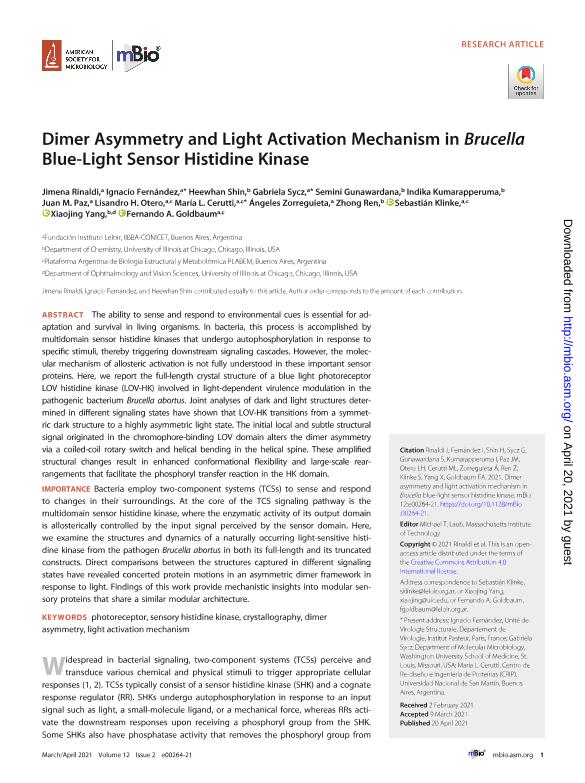Artículo
Dimer asymmetry and light activation mechanism in brucella blue-light sensor histidine kinase
Rinaldi, Jimena Julieta ; Fernandez, Ignacio
; Fernandez, Ignacio ; Shin, Heewhan; Sycz, Gabriela
; Shin, Heewhan; Sycz, Gabriela ; Gunawardana, Semini; Kumarapperuma, Indika; Aragón Paz, Juan Manuel
; Gunawardana, Semini; Kumarapperuma, Indika; Aragón Paz, Juan Manuel ; Otero, Lisandro Horacio
; Otero, Lisandro Horacio ; Cerutti, Maria Laura
; Cerutti, Maria Laura ; Zorreguieta, Ángeles
; Zorreguieta, Ángeles ; Ren, Zhong; Klinke, Sebastian
; Ren, Zhong; Klinke, Sebastian ; Yang, Xiaojing; Goldbaum, Fernando Alberto
; Yang, Xiaojing; Goldbaum, Fernando Alberto
 ; Fernandez, Ignacio
; Fernandez, Ignacio ; Shin, Heewhan; Sycz, Gabriela
; Shin, Heewhan; Sycz, Gabriela ; Gunawardana, Semini; Kumarapperuma, Indika; Aragón Paz, Juan Manuel
; Gunawardana, Semini; Kumarapperuma, Indika; Aragón Paz, Juan Manuel ; Otero, Lisandro Horacio
; Otero, Lisandro Horacio ; Cerutti, Maria Laura
; Cerutti, Maria Laura ; Zorreguieta, Ángeles
; Zorreguieta, Ángeles ; Ren, Zhong; Klinke, Sebastian
; Ren, Zhong; Klinke, Sebastian ; Yang, Xiaojing; Goldbaum, Fernando Alberto
; Yang, Xiaojing; Goldbaum, Fernando Alberto
Fecha de publicación:
03/2021
Editorial:
American Society for Microbiology
Revista:
mBio
ISSN:
2150-7511
e-ISSN:
2161-2129
Idioma:
Inglés
Tipo de recurso:
Artículo publicado
Clasificación temática:
Resumen
The ability to sense and respond to environmental cues is essential for adaptation and survival in living organisms. In bacteria, this process is accomplished by multidomain sensor histidine kinases that undergo autophosphorylation in response to specific stimuli, thereby triggering downstream signaling cascades. However, the molecular mechanism of allosteric activation is not fully understood in these important sensor proteins. Here, we report the full-length crystal structure of a blue light photoreceptor LOV histidine kinase (LOV-HK) involved in light-dependent virulence modulation in the pathogenic bacterium Brucella abortus. Joint analyses of dark and light structures determined in different signaling states have shown that LOV-HK transitions from a symmetric dark structure to a highly asymmetric light state. The initial local and subtle structural signal originated in the chromophore-binding LOV domain alters the dimer asymmetry via a coiled-coil rotary switch and helical bending in the helical spine. These amplified structural changes result in enhanced conformational flexibility and large-scale rearrangements that facilitate the phosphoryl transfer reaction in the HK domain. IMPORTANCE Bacteria employ two-component systems (TCSs) to sense and respond to changes in their surroundings. At the core of the TCS signaling pathway is the multidomain sensor histidine kinase, where the enzymatic activity of its output domain is allosterically controlled by the input signal perceived by the sensor domain. Here, we examine the structures and dynamics of a naturally occurring light-sensitive histidine kinase from the pathogen Brucella abortus in both its full-length and its truncated constructs. Direct comparisons between the structures captured in different signaling states have revealed concerted protein motions in an asymmetric dimer framework in response to light. Findings of this work provide mechanistic insights into modular sensory proteins that share a similar modular architecture.
Archivos asociados
Licencia
Identificadores
Colecciones
Articulos(SEDE CENTRAL)
Articulos de SEDE CENTRAL
Articulos de SEDE CENTRAL
Citación
Rinaldi, Jimena Julieta; Fernandez, Ignacio; Shin, Heewhan; Sycz, Gabriela; Gunawardana, Semini; et al.; Dimer asymmetry and light activation mechanism in brucella blue-light sensor histidine kinase; American Society for Microbiology; mBio; 12; 2; 3-2021; 1-18
Compartir
Altmétricas



